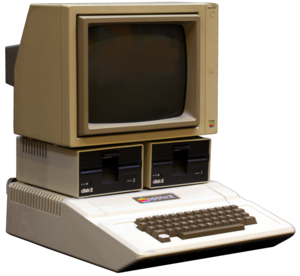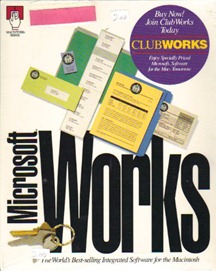With the untimely passing of Steve Jobs this week, like many people, I reflected on how I've been impacted by his contributions. I never met Steve or even saw him in person, but Apple and Steve Jobs definitely played a big role in my life.
My first programming class was summer school after 7th grade (1981?). We had Apple II computers with black-and-white 9" monitors and 110 baud teletype terminals connected to MECC (Minnesota Educational Computing Consortium). The Apples would overheat, so we'd have to open them up and fan them with their lids, but I didn't care. They were pretty magical. Over the next few summers, I improved my Applesoft BASIC programming and learned 6502 Assembly. (I didn't realize the Applesoft BASIC came from Microsoft and was an amalgamation of the two names.)
 We eventually bought an Apple II+ with 48K of RAM, two floppy drives, an Amdek color monitor, and an Epson dot matrix printer. (This was in addition to the TRS-80 Model III we had first; we were definitely the first house of anyone I knew with two computers at home.) My friends and I pirated a lot of software (LockSmith is your friend) and played a lot of games like Loderunner, Choplifter, Castle Wolfenstein, and especially Wizardry.
We eventually bought an Apple II+ with 48K of RAM, two floppy drives, an Amdek color monitor, and an Epson dot matrix printer. (This was in addition to the TRS-80 Model III we had first; we were definitely the first house of anyone I knew with two computers at home.) My friends and I pirated a lot of software (LockSmith is your friend) and played a lot of games like Loderunner, Choplifter, Castle Wolfenstein, and especially Wizardry.
I moved on to teaching Apple programming at home for $25 for five one hour lessons (maybe it was five two hour lesson); this was big money at the time since I was in ninth grade or something. I also wrote an Apple II database program for my school district to keep track of all of the padlock combinations for the lockers; as a result, I could open pretty much any lock in our school district. I got paid in stacks of floppy disks for this. I also got to borrow the first hard drive I ever saw -- a VCR-sized 5MB Winchester (I think); it was partitioned as something like two hundred floppy drives since the OS couldn't support big volumes.
At Stanford, I was a diehard Mac guy, with my Mac Plus with two 800K floppy drives (I eventually upgraded to a Mac SE with a 40MB aftermarket hard drive -- hot stuff.) I also worked at MicroDisc, the computer department of the Stanford Bookstore. At the time, we were the largest Apple reseller in the world. Senior year, I would borrow the new Mac Portable from the store on weekends. I would work on my programming projects at Denny's, drinking their bottomless coffee for hours. Most people hadn't seen a portable computer before, so I was definitely a trendsetter for the now-ubiquitous laptop-in-coffee shop scene.
 I took this Mac experience to my first job Microsoft where I worked on Works for Macintosh 3.0 and 4.0. (I think my name is on one of the mailing labels on the box shot to the right.) I had a nice Mac IIci on my desk, but our developers had the screaming-fast (then) Mac IIfx machines. (I remember being amazed that the MacIIfx basically had two Apple IIs inside just to monitor the ADB ports. We'd come a long way...)
I took this Mac experience to my first job Microsoft where I worked on Works for Macintosh 3.0 and 4.0. (I think my name is on one of the mailing labels on the box shot to the right.) I had a nice Mac IIci on my desk, but our developers had the screaming-fast (then) Mac IIfx machines. (I remember being amazed that the MacIIfx basically had two Apple IIs inside just to monitor the ADB ports. We'd come a long way...)
My team also ran the Mac lab where we got to see all of the new Mac hardware before they released. Back then, we had a lot of Macs around Microsoft. Every printer room had Apple Laserwriters as well as HP printers, and a lot of people used Word and Excel for Mac instead of on Windows 3.0 since the Mac versions were better.
I also worked on Microsoft Bookshelf for Mac a few years later. (Much) more recently, I got back into the Apple scene with my team's Bing for iPad project, the first Microsoft iPad application.
Of course, even when I wasn't working directly on Apple products, Apple affected me a great deal. There's no question in my mind that Apple helped make Microsoft better by providing a great competitor. They had (and have) a different approach to making products that we envied, even when they weren't making as much money as we were (things have changed).
So, thanks, Steve, for all you've done for me and my life over the last thirty years. RIP.
Leave a comment